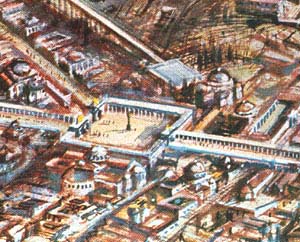 Contents -
Previous Article -
Next Article
Contents -
Previous Article -
Next Article
It was in the planning of new towns that the genius of Roman enginers and civic planners was given a chance to create a city of lasting beauty and orderly efficiency. When small to medium sized cities were built where there had been only empty land, Roman engineers often followed a standard plan based on the Roman army camp or castra. These thorough people with their measuring rods and gromas that would meet the needs of its growing population for many years to come.
David Macaulay, in his excellent book City: A Story of Roman Planning and Engineering gives a step - by - step description of the building of a Roman town from the selection of a suitable site to the daily flow of urban life after the city is finished and functioning. Like his other books on the history of architecture and engineering, this one is also filled with his clear and accurate drawings and his thorough descriptions in easy to understand language.
The image above is from an illustration showing a bird's eye view of the city of Constantinople around the year 1000 A.D. Three major streets, each lined with colonnaded sidewalks lead into the Forum Tauri, one of many forums in this magnificent city of late antiquity.
Go to next article:
Go back to previous article: